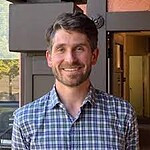Americans spend around 90 percent of their lives indoors and are exposed to many indoor contaminants for longer durations, often at higher concentrations compared to outdoor environments. [1] The scientific literature on exposures to contaminants like particulate matter, per- and polyfluoroalkyl substances (PFAS), and methylene chloride in the indoor environment and in building materials have been linked to many adverse health effects such as respiratory and cardiovascular disease, reproductive and developmental disorders, suppressed immune systems, and cancer. [2] [3] [4] Certain pollutants like particulate matter found indoors also contribute to environmental health disparities, while occupational exposures to toxic chemicals used in building materials increase risks of many poor health outcomes and death.
During this webinar, MyDzung T. Chu, Tom Bruton, and Annie Hoang presented recent research examining the health impacts of exposure to particulate matter, PFAS, and methylene chloride in the built environment. They also discussed potential opportunities for protecting vulnerable populations including environmental justice communities and workers facing increased risks of harmful exposure.
Socioeconomic Disparities in Indoor PM2.5
In residential settings, fine particulate matter (PM2.5) concentrations are highly variable indoors, with evidence for socioeconomic exposure disparities. In this talk, Dr. MyDzung T. Chu shared findings from the Home-based Observation and Monitoring Exposure (HOME) Study where she and coauthors investigated drivers of residential PM2.5concentrations of non-ambient origin in an urban environmental justice community. She focused on socioeconomic disparities in indoor PM2.5and the application of real-time monitoring and statistical methods to inform multi-level interventions to address PM2.5exposure disparities. This research is part of the Center for Research on Environmental and SocialStressors in Housing across the Life Course (CRESSH) (www.cressh.org)
PFAS in the built environment
Building materials are an important use of PFAS that have received relatively little attention. In this talk Dr. Tom Bruton went over highlights from a recent Green Science Policy Institute report documenting PFAS uses in the building industry, including in roofing materials, flooring, paints and coatings, sealants, glass, and more. Dr. Bruton also reviewed exposure concerns and discuss potential paths forward for reducing PFAS use in the built environment.
Methylene Chloride: It's Toxic to Human Health
Methylene chloride, often found in paint strippers, cleaners, adhesives, and sealants,is a toxic chemical that can lead to a rapid loss of consciousness leading to death and is considered a likely human carcinogen. The EPA has acknowledged 53 deaths due to methylene chloride since 1980, but an Assessment of Methylene Chloride-Related Fatalities in the United States, 1980-2018 has identified at least 85 deaths in that same timeframe. The Poison Control Centers have received nearly 40,000 calls due to methylene chloride-related poisonings in the past four decades. Lead author, Ms. Annie Hoang discussed results of this research which found that fatalities from methylene chloride exposure were disproportionately among workers. Ms. Hoang also highlighted the need for stronger worker protections and the use of safer substitutes.
Featured Speakers
 MyDzung T. Chu, PhD, MSPH, is an postdoctoral scientist at the Milken Institute School of Public Health, George Washington University in the Department of Environmental and Occupational Health. Her research focuses on socio-contextual drivers of environmental exposure disparities, with a specific focus on housing access and quality, air pollution, and immigrant health. Her current research investigates the impact of federal housing assistance on residential environmental exposures using novel data linkages at the national level. She also serves on the boards of the Healthy Buildings Network and the Asian American Resource Workshop. Dr. Chu received her PhD in Population Health Sciences from Harvard University, is a former Agents of Change in Environmental Health Fellow, and a Gates Millennium Scholar. You can connect with her on LinkedIn or Twitter (@mydz_C).
MyDzung T. Chu, PhD, MSPH, is an postdoctoral scientist at the Milken Institute School of Public Health, George Washington University in the Department of Environmental and Occupational Health. Her research focuses on socio-contextual drivers of environmental exposure disparities, with a specific focus on housing access and quality, air pollution, and immigrant health. Her current research investigates the impact of federal housing assistance on residential environmental exposures using novel data linkages at the national level. She also serves on the boards of the Healthy Buildings Network and the Asian American Resource Workshop. Dr. Chu received her PhD in Population Health Sciences from Harvard University, is a former Agents of Change in Environmental Health Fellow, and a Gates Millennium Scholar. You can connect with her on LinkedIn or Twitter (@mydz_C).
 Tom Bruton, PhD, MSE, is a Senior Scientist at the Green Science Policy Institute, which works at the intersection of science, policy, and business to reduce the use of harmful chemicals. Tom leads the Institute's research and policy work on PFAS. He received his Ph.D. in environmental engineering at UC Berkeley, where his research focused on cleanup of chemical contaminants, including PFAS, in soil and groundwater.
Tom Bruton, PhD, MSE, is a Senior Scientist at the Green Science Policy Institute, which works at the intersection of science, policy, and business to reduce the use of harmful chemicals. Tom leads the Institute's research and policy work on PFAS. He received his Ph.D. in environmental engineering at UC Berkeley, where his research focused on cleanup of chemical contaminants, including PFAS, in soil and groundwater.
 Annie Hoang, MPH, is a medical student in the Program in Medical Education for the Urban Underserved (PRIME-US), a specialized five-year track at the University of California, San Francisco (UCSF) School of Medicine. Her work focuses broadly on advancing health equity in the built environment. She received her MPH in health policy at the Harvard TH Chan School of Public Health. She graduated with Distinction in Molecular Cellular Developmental Biology Intensive from Yale University.
Annie Hoang, MPH, is a medical student in the Program in Medical Education for the Urban Underserved (PRIME-US), a specialized five-year track at the University of California, San Francisco (UCSF) School of Medicine. Her work focuses broadly on advancing health equity in the built environment. She received her MPH in health policy at the Harvard TH Chan School of Public Health. She graduated with Distinction in Molecular Cellular Developmental Biology Intensive from Yale University.
 El’gin Avila, MPH, CPH, is the Director of Occupational and Environmental Health (OEH) and Equity for the BlueGreen Alliance, and an Industrial Hygienist PhD student at the University of Minnesota. Originally from Detroit, Michigan, El’gin’s experiences have shaped his approach to population health and social justice. His passion stems from his experiences and knowledge of environmental and social injustices that have plagued disenfranchised and marginalized communities both in his hometown and abroad. This fuels the work he does as he aims to bring a more just approach to worker and environmental health, gig-work policy, housing and building materials, workforce precarity, environmental sustainability, and much more. El’gin Avila has worked on several projects leading to changes in federal OSHA’s implementation of COVID-19 response protocols for respiratory protection programs, and has a documented history providing technical assistance and expertise to community organizations at the local and state level. You can connect with him on LinkedIn or Twitter.
El’gin Avila, MPH, CPH, is the Director of Occupational and Environmental Health (OEH) and Equity for the BlueGreen Alliance, and an Industrial Hygienist PhD student at the University of Minnesota. Originally from Detroit, Michigan, El’gin’s experiences have shaped his approach to population health and social justice. His passion stems from his experiences and knowledge of environmental and social injustices that have plagued disenfranchised and marginalized communities both in his hometown and abroad. This fuels the work he does as he aims to bring a more just approach to worker and environmental health, gig-work policy, housing and building materials, workforce precarity, environmental sustainability, and much more. El’gin Avila has worked on several projects leading to changes in federal OSHA’s implementation of COVID-19 response protocols for respiratory protection programs, and has a documented history providing technical assistance and expertise to community organizations at the local and state level. You can connect with him on LinkedIn or Twitter.
This webinar was moderated by El'gin Avila, Director of Occupational and Environmental Health (OEH) and Equity for the BlueGreen Alliance. It lasted for 70 minutes and was recorded for our call and webinar archive.
